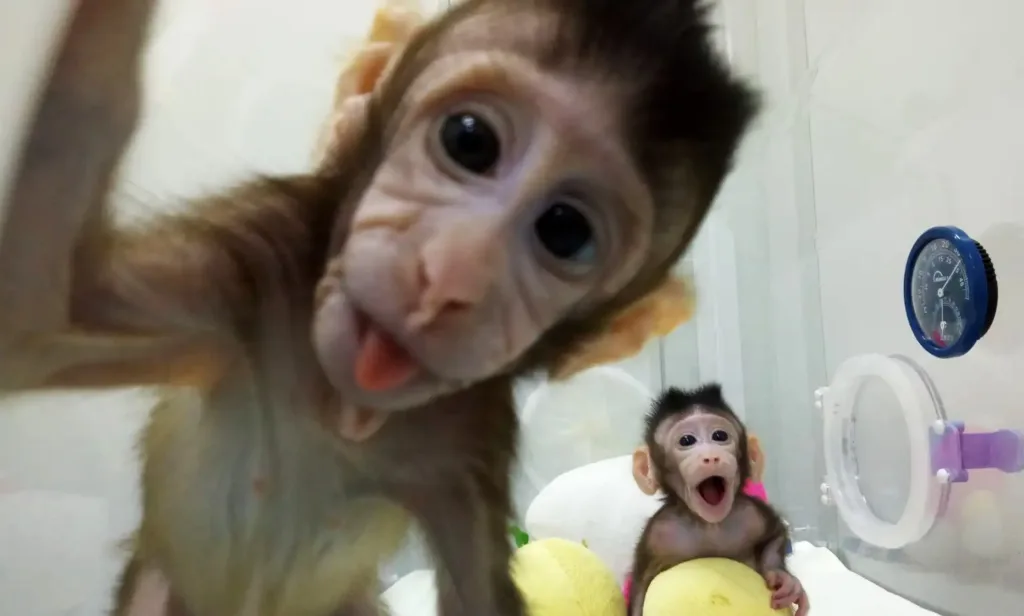Cloning Monkeys for Gene Technology:
In 2018, a groundbreaking scientific achievement took place in China as researchers successfully cloned two monkeys, Zhong Zhong and Hua Hua, using a process similar to the one that created Dolly the sheep. These identical long-tailed macaques paved the way for potential advancements in medical research related to human diseases. This significant breakthrough sparked further experimentation, leading to the cloning of five monkeys with a genetically engineered sleep disorder in 2019. Fast forward to 2024, where scientists in China announced the successful cloning of a healthy rhesus monkey named Retro, using an enhanced method derived from the process that gave rise to Dolly the sheep.

Benefits of Cloning Monkeys:
The cloning of monkeys holds promising potential across various domains, including medical research and conservation efforts. Researchers believe that cloning can be instrumental in studying diseases and developing innovative treatments. Additionally, the conservation of endangered or extinct monkey species could benefit from cloning technology, offering a lifeline to species on the brink of extinction.
The Journey to Successful Cloning:
In the realm of cloning, the journey has not been without its challenges. While Dolly the sheep represented a historic success in somatic cell cloning, it took several attempts for researchers to achieve similar success with monkeys. Notably, the cloned rhesus monkey named ReTro has defied expectations by not only surviving into adulthood but thriving for more than two years, marking a pivotal moment in cloning technology.
Ian Wilmut – Pioneer of Cloning:
The story of cloning is incomplete without mentioning Ian Wilmut, the pioneer behind Dolly the sheep. Dolly was cloned from a cell taken from the mammary gland of a six-year-old Finn Dorset sheep and an egg cell taken from a Scottish Blackface sheep. Born on July 5, 1996, Dolly’s creation opened new avenues for scientific exploration and the potential applications of cloning technology.
Non-Human Primates in Medical Research:
Non-human primates (NHPs), particularly monkeys, share high genetic similarity with humans, making them invaluable models for studying human diseases. This resemblance has led to the development of transgenic NHP models and the use of CRISPR/Cas9-mediated genome editing techniques. From green fluorescent protein-expressing monkeys to sophisticated models mimicking human neurodegenerative diseases, the progress in this field holds promise for advancing our understanding of complex diseases.
Challenges and Future Prospects:
While CRISPR/Cas9-mediated NHP modeling has shown remarkable progress, concerns such as off-target and mosaic mutations have surfaced. However, recent advancements in genome editing techniques are expected to overcome these challenges, providing exciting prospects for human disease studies.
The journey from Dolly the sheep to the successful cloning of monkeys has marked significant strides in genetic technology. Cloning monkeys not only holds promise for medical research and conservation but also exemplifies the potential of CRISPR/Cas9-mediated genome editing in advancing our understanding of complex human diseases. As the scientific community continues to push the boundaries of genetic research, the future appears bright for groundbreaking discoveries that could revolutionize medicine and conservation efforts alike.
References:
Doi K. and Takeuchi Y. (2015). Gene therapy using retrovirus vectors: vector development and biosafety at clinical trials. Uirusu 65, 27-36. 10.2222/jsv.65.27 [PubMed] [CrossRef] [Google Scholar]
Fu Y., Sander J. D., Reyon D., Cascio V. M. and Joung J. K. (2014). Improving CRISPR-Cas nuclease specificity using truncated guide RNAs. Nat. Biotechnol. 32, 279-284. 10.1038/nbt.2808 [PMC free article] [PubMed] [CrossRef] [Google Scholar]
Fujiyama A., Watanabe H., Toyoda A., Taylor T. D., Itoh T., Tsai S. F., Park H. S., Yaspo M. L., Lehrach H., Chen Z. et al. (2002). Construction and analysis of a human-chimpanzee comparative clone map. Science 295, 131-134. 10.1126/science.1065199 [PubMed] [CrossRef] [Google Scholar]
Goff S. P. and Berg P. (1976). Construction of hybrid viruses containing SV40 and lambda phage DNA segments and their propagation in cultured monkey cells. Cell 9, 695-705. 10.1016/0092-8674(76)90133-1 [PubMed] [CrossRef] [Google Scholar]
Gurumurthy C. B. and Lloyd K. C. K. (2019). Generating mouse models for biomedical research: technological advances. Dis. Model. Mech. 12, dmm029462 10.1242/dmm.029462 [PMC free article] [PubMed] [CrossRef] [Google Scholar]

Its like you read my mind You appear to know so much about this like you wrote the book in it or something I think that you can do with a few pics to drive the message home a little bit but instead of that this is excellent blog A fantastic read Ill certainly be back
We sincerely appreciate your positive feedback and admiration for our modest effort.
Please assist us in spreading the word about our website.
With regards,
Find Soft News Research Team.
Never stop reaching. Onward!
We sincerely appreciate your positive feedback and admiration for our modest effort.
Please assist us in spreading the word about our website.
With regards,
Find Soft News Research Team.